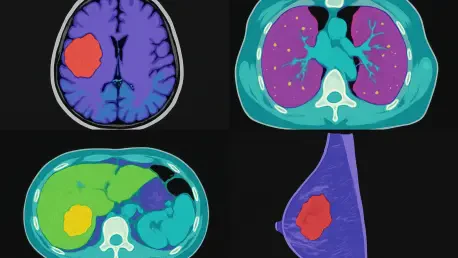What if a technology could transform the way doctors analyze intricate medical scans, cutting down hours of work into mere minutes with unerring precision, while making diagnostics more accessible worldwide? Picture a hospital overwhelmed with brain MRI scans, where clinicians struggle to keep up with the demand for accurate diagnoses. Enter MetaSeg AI, a groundbreaking tool that promises to redefine medical image segmentation, making it faster, more affordable, and widely accessible to healthcare providers across the globe. This innovation, unveiled at a prestigious industry conference, signals a turning point in diagnostic imaging.
A Game-Changing Leap in Medical Imaging
Medical imaging has long been a cornerstone of modern healthcare, providing critical insights into the human body through scans like MRIs and CTs. However, the process of interpreting these images, particularly segmenting specific anatomical regions, has remained a significant bottleneck due to its complexity and time demands. MetaSeg AI emerges as a revolutionary solution, slashing the time and cost associated with analyzing complex scans while maintaining exceptional accuracy, as demonstrated in rigorous testing environments.
This tool, showcased at the Medical Image Computing and Computer Assisted Intervention Society (MICCAI) conference, offers a glimpse into a future where advanced diagnostics are no longer a luxury reserved for well-funded institutions. Its ability to handle intricate data with minimal resources positions it as a potential lifeline for hospitals and clinics worldwide. The impact of such a leap cannot be overstated, especially as the volume of medical imaging continues to grow exponentially.
The Urgent Need for Advanced Segmentation Tools
Segmenting medical images—identifying and labeling specific structures like the brain’s cerebral cortex or brain stem in an MRI—forms the backbone of accurate diagnoses, surgical planning, and cutting-edge research. Traditional methods often rely on manual labeling by clinicians, a process that is not only painstakingly slow but also prone to human error under tight schedules. Even existing AI solutions, such as the widely used U-Nets, require enormous datasets and powerful computing resources, creating barriers for smaller or underfunded facilities.
As medical imaging evolves with increasingly detailed 3D scans and larger datasets, the demand for efficient and scalable tools intensifies. Many regions, particularly in developing areas, lack the infrastructure to support resource-heavy technologies, leaving a gap in access to quality diagnostics. This pressing challenge underscores the need for a solution that can democratize advanced imaging analysis without compromising on precision or reliability.
Unpacking MetaSeg’s Cutting-Edge Technology
MetaSeg AI distinguishes itself through a novel approach that diverges from conventional AI models like U-Nets. By integrating implicit neural representations (INRs)—a technique that represents images as mathematical formulas for pixel or voxel values—with meta-learning, often described as “learning to learn,” MetaSeg adapts to new scans without the need for extensive retraining. This adaptability ensures that the tool remains effective even when faced with previously unseen data, a significant advantage in clinical settings.
Key achievements of MetaSeg include matching the accuracy of U-Nets while using 90% fewer parameters, drastically reducing computational costs. Experiments with both 2D and 3D brain MRI data have validated its performance, showcasing its potential to handle diverse imaging challenges. Furthermore, its recognition with the best paper award at MICCAI, selected from over 1,000 submissions, highlights its transformative promise for the field of medical imaging.
The technology’s efficiency stems from its ability to optimize quickly during testing phases, decoding image features into precise segmentation labels in real time. This breakthrough means that hospitals no longer need to invest in expensive hardware or prolonged training periods to achieve high-quality results. MetaSeg’s design prioritizes practicality, ensuring that even facilities with limited resources can benefit from state-of-the-art segmentation capabilities.
Voices from the Forefront of AI Innovation
Experts behind MetaSeg AI emphasize its potential to reshape medical imaging practices. Guha Balakrishnan, an assistant professor at Rice University and a key developer of the technology, notes, “This tool marks a paradigm shift by enabling high-quality image processing even in resource-constrained environments.” His perspective reflects the broader goal of making advanced healthcare tools accessible to a wider audience, breaking down long-standing barriers.
Doctoral student Kushal Vyas, who played a pivotal role in the project, highlights the practical benefits: “Reducing the computational load means that more hospitals and clinics can adopt cutting-edge segmentation without financial strain.” Supported by funding from the National Institutes of Health and the National Science Foundation, alongside Rice University’s Digital Health Initiative, MetaSeg’s development showcases a collaborative effort to address real-world challenges in healthcare through AI.
These insights from the development team underscore a shared vision of innovation that prioritizes impact over complexity. Their work, grounded in academic rigor and practical application, points to a growing movement within the industry to leverage AI for tangible improvements in patient care. Such endorsements lend credibility to MetaSeg’s potential as a catalyst for change.
Practical Impacts and Steps Toward Implementation
For healthcare providers, MetaSeg AI presents immediate opportunities to enhance diagnostic workflows, particularly in brain MRI analysis where speed and accuracy are paramount. Hospitals can integrate this tool as a cost-effective alternative to traditional AI models, ensuring high-quality segmentation without the burden of hefty investments in computing infrastructure. This accessibility could prove transformative for facilities operating on tight budgets or in remote locations.
Researchers are encouraged to explore MetaSeg’s applications beyond brain imaging, testing its effectiveness across other types of medical scans to broaden its utility. Tech teams within medical institutions might collaborate with developers to tailor the model to specific clinical requirements, addressing unique challenges in diverse patient populations. Such customization could unlock new possibilities for personalized medicine and specialized care.
Looking ahead, the path to widespread adoption involves strategic partnerships between technology developers, healthcare providers, and regulatory bodies to ensure seamless integration into existing systems. Pilot programs in varied clinical settings could provide valuable data on MetaSeg’s performance under real-world conditions, paving the way for global implementation. These steps collectively aim to improve patient outcomes by making advanced diagnostics a standard rather than an exception.
Reflecting on a Milestone in Medical Technology
Looking back, the introduction of MetaSeg AI stood as a defining moment in the evolution of medical imaging, addressing long-standing inefficiencies with a bold, innovative approach. Its ability to deliver precise segmentation with minimal resources challenged the status quo, proving that transformative technology could thrive even in constrained environments. The recognition it garnered at MICCAI served as a testament to its significance within the scientific community.
The journey of this groundbreaking tool highlighted the power of collaboration between academia, healthcare, and funding bodies in solving critical challenges. As MetaSeg gained traction, it became clear that the next steps involved scaling its reach through targeted pilot programs and cross-disciplinary partnerships. Expanding its application to diverse imaging types promised to further solidify its impact on global healthcare.
Ultimately, the legacy of MetaSeg AI rested in its potential to inspire future innovations, encouraging the industry to prioritize accessibility alongside advancement. Stakeholders were urged to invest in real-world testing and adaptation, ensuring that this technology reached the hospitals and clinics most in need. This commitment to actionable progress marked a hopeful chapter in the ongoing effort to enhance patient care through intelligent solutions.









